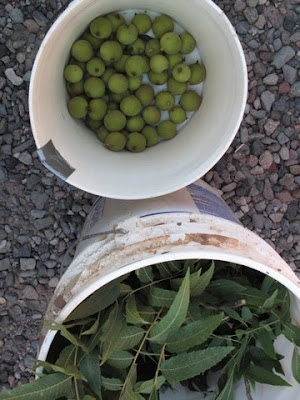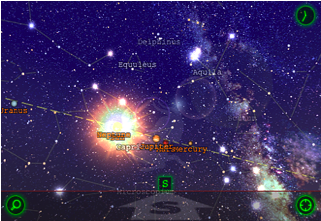



 Walnuts (Juglans major) in the southwestern states are beginning to ripen . . . time to try something I've had in my nature notes for some time: vin noix (green walnut wine), made from noix de Saint-Jean (Saint John's walnut). One of the best tutorials on the origin and making of this European aperitif is on William Rubel's website (williamrubel.com). Traditionally in France the walnuts (from J. regia) are harvested around June 24, which is Saint Jean's Day, the feast of Saint John. Our southwestern species don't begin to grow until later in July. I don't know if our wild walnuts will yield a quality flavored product (it's actually one of several flavorings in what's known as a fortified wine, since it's made by infusing alcohol and wine with botanicals and spices). The recipes refer to the astringent quality of the walnuts, and ours certainly have that characteristic. I gathered these in New Mexico's Mimbres Valley, northeast of Silver City.
Walnuts (Juglans major) in the southwestern states are beginning to ripen . . . time to try something I've had in my nature notes for some time: vin noix (green walnut wine), made from noix de Saint-Jean (Saint John's walnut). One of the best tutorials on the origin and making of this European aperitif is on William Rubel's website (williamrubel.com). Traditionally in France the walnuts (from J. regia) are harvested around June 24, which is Saint Jean's Day, the feast of Saint John. Our southwestern species don't begin to grow until later in July. I don't know if our wild walnuts will yield a quality flavored product (it's actually one of several flavorings in what's known as a fortified wine, since it's made by infusing alcohol and wine with botanicals and spices). The recipes refer to the astringent quality of the walnuts, and ours certainly have that characteristic. I gathered these in New Mexico's Mimbres Valley, northeast of Silver City.
Vin de Noix (from William Rubel)
40 young walnuts that can be pierced with a needle, rinsed and quartered
1 liter alcohol such as brandy, marc, eau de vie, or vodka
5 liters red wine
1 kg sugar (2 pounds)
One or more of the following are often added, but are optional
12 walnut leaves
Zest of 1 orange
4 to 8 cloves
1 vanilla bean
[I reduced the recipe to 15 wild walnuts; 1.25 L red Italian table wine; .25 L vodka; 225 g sugar; 4 walnut leaves; half a vanilla bean; zest of 1/4 orange; 4 cloves.]
1. Pick the walnuts in late June when the walnuts are well formed, but can still be pierced with a needle. Place all of the ingredients in an 8 quart (8 liter) non-reactive container with a lid. I use a large glass jar. Store in a cool dark place for 6 to 8 weeks, shaking occasionally.
2. Strain through cheesecloth into a bowl. Taste, and adjust the sugar if you want the drink to be sweeter. Bottle and store in a cool dark place until the cold weather.
 Check back in eight weeks for a taste test. I'll also look for ripe walnuts in the fall; these make excellent pigment.
Check back in eight weeks for a taste test. I'll also look for ripe walnuts in the fall; these make excellent pigment. What bird was that? The other day we drove down to a pond south of us, and were astonished to find hundreds of birds enjoying the bounty of water in the desert. I didn't have my full field guide set with me, but I was able to confirm Common Ground Dove calling with National Geographic's Handheld Birds app - most every entry includes sound as well as images and data.
What bird was that? The other day we drove down to a pond south of us, and were astonished to find hundreds of birds enjoying the bounty of water in the desert. I didn't have my full field guide set with me, but I was able to confirm Common Ground Dove calling with National Geographic's Handheld Birds app - most every entry includes sound as well as images and data. I have a real ineptitude for remembering astronomy. My all-time-favorite app thus far is StarWalk. Like having a mini planetarium and personal starguide in your pocket. It's difficult to describe just how cool this app is - you can zoom in and out, scroll 360 degrees around the dome of the sky, including what's below the horizon . . . click on a planet or star or cluster and get full data on it . . . and search for the name of a celestial object and it will show you where it is - all in exact relation to your current location. So when I note in my journal the arresting moonscape-and-planet I saw at 4 am, I can look up exactly which planet.
I have a real ineptitude for remembering astronomy. My all-time-favorite app thus far is StarWalk. Like having a mini planetarium and personal starguide in your pocket. It's difficult to describe just how cool this app is - you can zoom in and out, scroll 360 degrees around the dome of the sky, including what's below the horizon . . . click on a planet or star or cluster and get full data on it . . . and search for the name of a celestial object and it will show you where it is - all in exact relation to your current location. So when I note in my journal the arresting moonscape-and-planet I saw at 4 am, I can look up exactly which planet. I always note the times of sun and moon rising and setting, as well as the moon phase. This great app, called Sun and Moon, always keeps it at my fingertips.
I always note the times of sun and moon rising and setting, as well as the moon phase. This great app, called Sun and Moon, always keeps it at my fingertips.
 I will have new bracelets and earrings on sale this weekend at my new online store. Focusing on new metals for me ~ brass and steel with hammered, oxidized and colored finishes, and combining them with pearls and delicate strips of tulle ribbon.
I will have new bracelets and earrings on sale this weekend at my new online store. Focusing on new metals for me ~ brass and steel with hammered, oxidized and colored finishes, and combining them with pearls and delicate strips of tulle ribbon.


 Add drops of a mild acid (vinegar or lemon juice) until the liquid turns from rich brown to deep black.
Add drops of a mild acid (vinegar or lemon juice) until the liquid turns from rich brown to deep black.




 There has been a fire on a ridge in the Baboquivari Mountains west and south of us . . . we watched it grow in the night, an eerie string of fire-pearls creeping up the mountain ridge. Now it is threatening Brown Canyon and the house where we used to live . . . and Elkhorn Ranch, owned by Mary and Charlie Miller . . . the fire was started by an illegal immigrant, trying to signal for help. We are in California right now and are watching and hearing the news from afar . . .
There has been a fire on a ridge in the Baboquivari Mountains west and south of us . . . we watched it grow in the night, an eerie string of fire-pearls creeping up the mountain ridge. Now it is threatening Brown Canyon and the house where we used to live . . . and Elkhorn Ranch, owned by Mary and Charlie Miller . . . the fire was started by an illegal immigrant, trying to signal for help. We are in California right now and are watching and hearing the news from afar . . .




